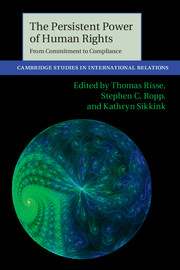Book contents
- Frontmatter
- Contents
- Figures
- Tables
- Contributors
- Preface
- Part I Introduction and stock-taking
- Part II Conceptual and methodological issues
- Part III From ratification to compliance
- 7 The normative context of human rights criticism
- 8 The United States and torture
- 9 Resisting the power of human rights
- 10 The “Arab Spring” and the spiral model
- Part IV From commitment to compliance
- References
- Index
7 - The normative context of human rights criticism
Treaty ratification and UN mechanisms
Published online by Cambridge University Press: 05 March 2013
- Frontmatter
- Contents
- Figures
- Tables
- Contributors
- Preface
- Part I Introduction and stock-taking
- Part II Conceptual and methodological issues
- Part III From ratification to compliance
- 7 The normative context of human rights criticism
- 8 The United States and torture
- 9 Resisting the power of human rights
- 10 The “Arab Spring” and the spiral model
- Part IV From commitment to compliance
- References
- Index
Summary
How do human rights norms condition states’ responses to international criticism? As noted in the introductory chapters, the spiral model outlines a process in which focused communication, argument and, in some cases, persuasion can take place once a state recognizes human rights norms’ prescriptive status. A regularized, some might say stylized, version of human rights communication takes place both when states accede to global human rights treaties and when governments are addressed under the procedures that have evolved for consideration of countries’ human rights records at the United Nations (UN). If international norms, rules and principles provide a backdrop for further engagement and argument about facts and accountability, we might expect to see differing levels of change in a country’s human rights record depending on how deeply, and under what circumstances, it engages with the international human rights framework. This chapter applies a form of dynamic time series analysis, a statistical technique, along with a short case study of UN action on Indonesia, to consider the effects of the discursive engagement represented by treaty commitment and whether human rights treaty compliance varies when a state receives additional international attention.
Commitment in the analysis below is indicated by the ratification of one or two major human rights treaties, the International Covenant on Civil and Political Rights (ICCPR, UN 1966), which entered into force in 1976, and the Convention against Torture and Other Cruel, Inhuman, or Degrading Treatment or Punishment (CAT, UN 1984), which entered into force in 1987. Compliance with human rights norms is based on a measure of the level of respect for basic physical integrity rights, described below. In addition to the expectations brought into relief when a state ratifies a human rights treaty, procedures within the UN framework can also be invoked to raise concerns about a country’s human rights record. Resolutions adopted by the UN Economic and Social Council (ECOSOC) in 1967 and 1970, known by their numbers as Resolutions 1235 (UN ECOSOC 1967) and 1503 (UN ECOSOC 1970), allow the UN to highlight the gap between international human rights standards and a country’s behavior, whether or not it is party to a human rights treaty. The procedures under the resolutions are institutionalized examples of human rights criticism, which is often referred to as “naming and shaming.”
- Type
- Chapter
- Information
- The Persistent Power of Human RightsFrom Commitment to Compliance, pp. 125 - 144Publisher: Cambridge University PressPrint publication year: 2013
- 10
- Cited by

